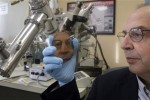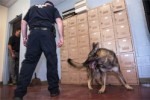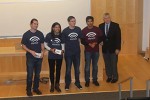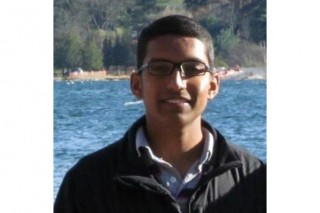News & Events
Research
Student Spotlight: Srikrishna Karanam April 29, 2016

Srikrishna Karanam, an ALERT Ph.D. student in Computer and Systems Engineering at Rensselaer Polytechnic Institute (RPI), has been “Searching for people in camera networks,” (the title of his doctoral thesis) with his faculty advisor, Prof. Richard Radke, for over three years.
As described by Srikrishna, “The overall goal of the project is to design and develop a system, called tag and track, to assist TSA officials in detecting and tracking persons of interest in critical and busy environments such as airports. My role is to develop and implement the underlying algorithms that drive the system.” (To see the related ALERT 101 video, click here).
After completing his Bachelor of Technology degree in Electronics and Communication Engineering from the National Institute of Technology Warangal in India, Srikrishna joined RPI as a Master’s student, initially involved in tracking people as they moved in videos, before joining ALERT’s video analytics research team.
When asked what about his work drives him, he states, “I am very passionate about algorithmic research being actually used to solve real-world problems. My involvement with ALERT has provided me with a wonderful opportunity to develop algorithms and systems keeping real-world constraints in mind… How do we ensure that the system works efficiently in such cases and does not ‘lose’ the person being tracked in the crowd? This is one of the several questions I want to address going forward.”
Naturally, there have been challenges along the way. Srikrishna and his team worked to design a user-friendly system so that someone unfamiliar with Computer Vision was able to utilize the software. He states that, “The system had to work in real-time on live video feeds in the airport, so developing efficient and optimized algorithms was critical.” As a result of his work, he has authored and co-authored 9 papers (including 1 journal article and 5 conference papers in press, as well as several submitted).
When asked about his experience working with Prof. Radke, he says, “I have immensely enjoyed working with Prof. Radke. He has given me a lot of independence in developing ideas for my dissertation, and I feel that has helped me grow as a researcher.”
After he completes his Ph.D., Srikrishna hopes to transition to industry, with the goal of continuing his work with Computer Vision, and finding the opportunity to implement both basic and applied research.
Of the impact his participation in the program has had on this research interests, Srikrishna states, “ALERT’s emphasis on transitioning laboratory research to real-world solutions has had a huge impact on my research philosophy. Now, when I think of possible solution approaches to a certain problem, ensuring that my approach is adaptable to real-world scenarios is a top priority.”
ALERT & Gordon-CenSSIS Research Represented at RISE:2016 April 29, 2016

On April 7th, Northeastern University held its fifth annual Research, Innovation and Scholarship Expo (RISE), known as RISE:2016. The expo is an opportunity for students and faculty members to showcase use-inspired scholarly research and fundamental discoveries that can be translated into real-world applications. At RISE:2016, more than a dozen ALERT, Gordon-CenSSIS, and other affiliated students presented their inventive engineering research projects to the general public as well as the RISE judges, who hail from industry, investment, political, and media-related backgrounds.
Research based in the R3 Thrust, Bulk Sensors and Sensor Systems, was especially visible at the expo and represented by both graduate and undergraduate students. PhD candidates Yukinori Fuse and Mohammad Tajdini demonstrated their respective work with Professors Carey Rappaport and Jose Martinez-Lorenzo on advanced imaging and algorithm development for forward-looking vehicle-based Ground Penetrating Radar (GPR). Undergraduate student researcher Anthony Bisulco was present to explain his efforts in rapid security threat detection using millimeter-wave imaging, which he conducts within Prof. Martinez-Lorenzo’s group.
Members of the 2015-2016 ALERT and Gordon-CenSSIS Scholars Program were also presenters at RISE:2016. Innovative investigations into such topics as breast cancer imaging, big-data computing, large-scale image database development were representative of the Scholars’ year-long projects and potent material for participation in RISE.
We congratulate our students and faculty sponsors on their well-received presentations at RISE:2016!
Northeastern News spotlights ALERT research in Airport Security Technologies April 28, 2016

FUTURE OF AIRPORT SECURITY – Northeastern News, 4/28/2016
According to the International Air Transport Association, about 8 million travelers make their way through airports around the world each day. Traditional security requires passengers to stand still while being screened, but Northeastern researchers are developing cutting-edge technology that can detect suspicious behavior—even when passengers are on the move…
Profs. Camps, Martinez, Radke, Rappaport, and Sznaier’s work is featured in this dynamic video story.
Read MoreTESSA02 Final Report Now Available April 1, 2016
The final report from the TESSA 02 Workshop, Fundamentals and Advances in Trace Sampling and Detection Workshop Information, is now available for download.
Read MoreThe Associated Press features ALERT Researcher Otto Gregory’s work February 17, 2016

SOUTH KINGSTOWN, R.I. (AP) — A University of Rhode Island professor has developed a sensor that detects the kind of explosive used in the Paris bombings, to try to stop future attacks.
Professor Otto Gregory compares his sensor to a dog’s nose, the gold standard in explosives detection. It “sniffs” the air for vapors emitted from explosives.
Photo Description: In this Tuesday, Jan. 26, 2016 photo University of Rhode Island engineering professor Otto Gregory, right, is reflected in a silicon wafer, center, that contains sensors to detect explosives, in front of a thin film surface analyzer, behind, in a laboratory on the school’s campus, in South Kingstown, R.I. He has developed a sensor that detects the explosive used in the Paris bombings, to try to stop future attacks. Gregory compares his sensor to a dog’s nose, the gold standard in explosives detection. It “sniffs” the air for vapors emitted from explosives. (AP Photo/Steven Senne)
ALERT researchers work to develop robust Canine Training Aids December 16, 2015

Because of their volatility, explosives are rarely used pure, they are often mixed with other materials such as polymers. Explosives are exposed to polymers for a variety of reason: (1) when they are “plasticized” for shaping; (2) when they are encased for safe handling, (e.g. dog training aids); and (3) when they are collected for forensic evidence or storage. ALERT has focused on finding the best materials for developing devices such as these.
As a result of our study of polymer/HME interactions, ALERT researchers have developed a method of polymer encapsulation that is used to create safe trace explosive sources for canine and instrument training. Polycarbonate microspheres containing only a low percentage of TATP have been demonstrated to last for years, yet produce pure TATP vapor when heated at the designated program rate. This approach provides canine handlers and instrument vendors with safe access to stored hazardous explosives at trace levels for use in detection, calibration, and validation of instruments as well and the training of explosives detecting canines.
ALERT has received enthusiastic support from law enforcement and instrument vendors and are in negotiation for possible licensing with a commercial vendor. In the near term, law enforcement agencies and instrument vendors are able to request these training aids directly from ALERT.
Oxley said “Some of our biggest service clients are law enforcement agencies. When some of the improvised devices came into vogue, they were too sensitive for law enforcement agencies to handle.” Oxley explained that for the Popular Science crew, her team not only conducted a demonstration, but ran a test to determine if the dogs detect pseudo explosives as they do the real explosives.
“It worked and we were really excited, because this was a first-time run during which the dogs were testing both,” said the chemistry professor and co-coordinator of the URI Forensic Science Partnership. “We wanted to make sure they could associate one with the other; that was an extremely important task.
“With K-9s, we are looking at the odor signature, and we have to do that on an explosive-by-explosive basis,” she said.She added that Metropolitan Transit Authority police took advantage of training opportunities at URI long before other groups, but more and more agencies are seeking training, including the federal Transportation Security Administration, which has rotated dozens of agents through the URI campus this summer.
Photo caption: Sgt. Bill Finucane of the Metropolitan Transportation Authority Police Department in New York works with McCarney, one of the department’s dogs, while testing canine explosive training aids developed by URI’s Jimmie Oxley and her team.
ALERT Students Received Top Award at URI’s Internet of Things Hackathon November 30, 2015

On Friday, November 13th, 2015, students at the “Internet of Things Hackathon,” at URI were divided into teams, assigned a problem to solve with modern technologies, and given the rest of the weekend to compete for the top prize. Three students from ALERT were teamed up to develop an idea for a product that could locate radiation sources in real time and help determine the exact location of a biological weapon. The team, comprised of Anthony Bisulco, a sophomore at Northeastern University, Darby Hoss, a graduate student from Purdue University, and Amanda Figueroa, a senior from the University of Puerto Rico Mayaguez, created a prototype of a system that determined the location of the radiation source based on measurements from remote, wearable sensors.
ADSA12 Final Report Now Available October 19, 2015
We are pleased to announce that the ADSA12 Workshop Final Report is now available for download at the following link:
ADSA12 Final Report – Personnel and Divested Items Screening at the Checkpoint
If you have any questions regarding the topics and technologies discussed at the workshop, please contact Carl Crawford at [email protected].
ALERT Phase 2 Year 2 Annual Report Available Online! September 29, 2015
ALERT is proud to announce that the Phase 2 Year 2 Annual Report is now available for download online. This report captures the progression of the research conducted in our four thrusts:
- R1 Characterization & Elimination of Illicit Explosives
- R2 Trace & Vapor Sensors
- R3 Bulk Sensors & Sensor Systems
- R4 Video Analytics & Signature Analysis
A full bibliography of publications and presentations conducted under ALERT support follows the individual project reports. Detailed descriptions of the Year 2 activities that took place in our Research and Transition, Education, Strategic Studies, Safety, and Information Protection Programs, as well as the ALERT Phase 2 Overview and Year 2 Highlights, Infrastructure and Evaluation, and Industrial/Practitioner and Government Partnerships can also be accessed in the Annual Report.
Read MoreStudent Spotlight Interview with Michael Collins September 28, 2015

Congratulations to Michael Collins, who graduated from Northeastern University in August 2014 with his MS in Electrical and Computer Engineering, as he is preparing to complete his participation in the ALERT DHS HS-STEM (Homeland Security Science, Technology, Engineering, and Mathematics) Career Development Program!
The Career Development Program (CDP) was established in 2011 with a grant to Northeastern University from the Department of Homeland Security, Science and Technology Directorate. In 2015 the program was expanded and renamed, and now awards fellowships to full-time students pursuing BS, MS or PhD degrees related to ALERT’s research. After completing their degree and other program requirements, graduates are required to obtain paid employment within the Homeland Security Enterprise for at least one year.
During his time at Northeastern, Michael worked with Prof. Carey Rappaport on a project focused on the feasibility of using Nuclear Quadrupole Resonance sensing for non-invasive detection of explosives hidden inside the body, in collaboration with Los Alamos National Laboratory.
Of his experience working with Prof. Rappaport, Michael says that, “having a great advisor makes all the difference in a research program. Professor Rappaport’s many insights and patient explanations taught me things that are hard to learn any other way.” As part of the CDP, Michael participated in a 10-week long internship with Los Alamos National Lab, and recalls the opportunity to visit New Mexico to collect data for his thesis as being one of the highlights of the program.
Now, Michael is working at the Centre for Maritime Research and Experimentation (CMRE) a NATO organization located in La Spezia, Italy. He began his search for Homeland Security Enterprise positions after graduation in August, 2014, and received his offer to start at CMRE in October, 2014. Michael was initially drawn to the Centre’s research on autonomous underwater vehicles (AUVs) for port security, anti-submarine warfare, and mine detection. So far, he has worked on technology that improves underwater communication, performed acoustic modeling, and has participated in a naval exercise in Norway. Of his current role, Michael says, “I am now in charge of a project that reduces the risk faced by submariners. Like the research that I conducted at ALERT, it’s good to know that my current work makes people safer.”
When asked to reflect on his experience working with Michael, Prof. Rappaport describes him as “an incredibly hard worker: when he sets his sights on a goal, no matter how ambitious or distant, he will attain it through sheer force of will. It’s great to see him succeed in this high responsibility job.”

